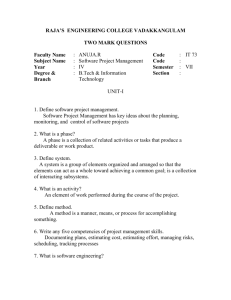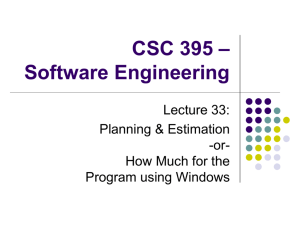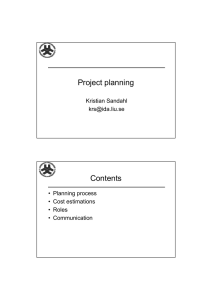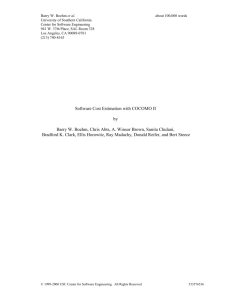Review of Some Estimating Techniques (Chapter 13)
advertisement
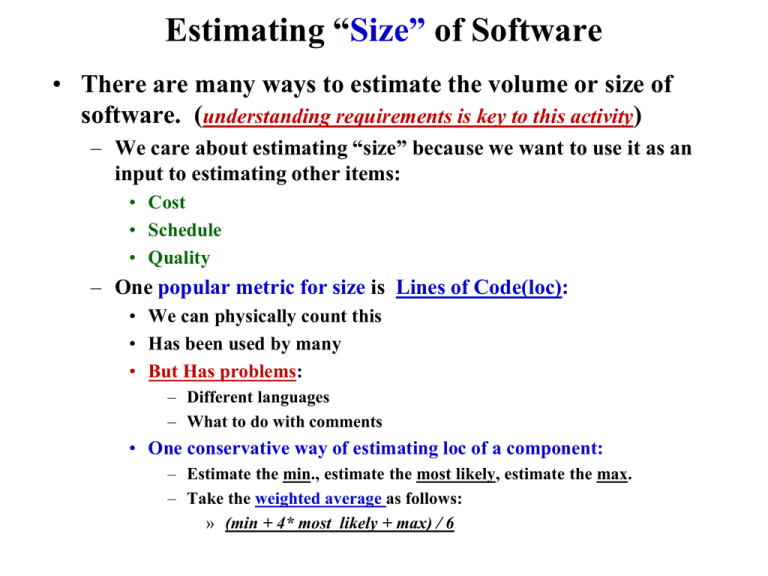
Estimating “Size” of Software • There are many ways to estimate the volume or size of software. (understanding requirements is key to this activity) – We care about estimating “size” because we want to use it as an input to estimating other items: • Cost • Schedule • Quality – One popular metric for size is Lines of Code(loc): • We can physically count this • Has been used by many • But Has problems: – Different languages – What to do with comments • One conservative way of estimating loc of a component: – Estimate the min., estimate the most likely, estimate the max. – Take the weighted average as follows: » (min + 4* most_likely + max) / 6 Cost (Effort)Estimation • In general, effort estimation is based on several parameters and the model ( E= a + b*S**c ): – – – – – – Personnel Environment Quality Size or Volume of work (e.g. loc) Process where S is the Size and a, b, and c are constants estimated with other parameters • a is the base cost needed to perform the project regardless of size • c is the exponent that shows whether the increase of S linearly affects the cost. If c=1 then it is linear. • b is a fixed “marginal” cost per change of S. Cost/Effort Estimation models • Some popular Effort Estimation methodologies: – Function Point (actually estimates size --- converts to effort) – COCOMO (Constructive Cost Model) Function Point • Proposed by Albrecht of IBM as an alternative metric to lines of code count for S, size of product. • Based on 5 major areas and a complexity table of (simple, average and complex set of weights: – – – – – simple average complex input 3 4 6 output 4 5 7 inquiry 3 4 6 master files 7 10 15 interfaces 5 7 10 • The Unadjusted Function Point (UFP) is : – UFP = w*Inp + w2*Out + w3*Inq + w4*MastF +w5*Intf Function Point (cont.) • 14 technical complexity factors are included, each “valued” between 0 and 5: – – – – – – – – – – – – – – data communications distributed data performance criteria heavy hardware usage high transaction rates online data entry online updating complex computations ease of installation ease of operation portability maintainability end-user efficiency reusability Function Point (cont.) • The sum of 14 technical complexity factors can have values of 0 through 70. • The the Total Complexity Factor(TCF) is defined as: – TCF = .65 + (.01 * Sum of 14 technical complexity factors) – Thus TCF may have values of 0.65 through 1.35. • Finally, Function Point (FP) is defined as: FP = UFP * TCF • To convert to effort or cost, one may use “historical” data of productivity and dollars per FP. (need a conversion factor) Simple Function Point Example • Consider the function that uses ‘Simple” weights from the table : – 2 inputs, 1 output, 0 inquiry, 0 master file, and 2 interfaces – UFP = 3* 2 + 4*1 + 3*0 + 7*0 + 5*2 = 20 – consider the 14 complexity factors : 0-data comm; 0-distrib data; 0-perf criteria; 0-hardware usage; 0-transaction rate; 1online data entry; 0-end user efficiency; 0-online update; 2complex computation;0-reusability; 0-ease of install; 0-ease of operation; 0-portability; 1-maintainability: – TCF = .65 + (.01 * 4 ) = .69 – FP = UFP * TCF – FP = 20 * .69 – FP = 13.8 Function Point Example (cont.) • What does 13.8 function points mean in terms of schedule and cost estimates ? • One can receive guidance from IFPUG (International Function Point User Group) to get some of the $/FP or person-days/FP data. • With “old IBM services division” data of 20 function points per person-month to perform “complete” development, 13.8 FP translates to approximately .7 person months or (22days * .7 = 15 person days) of work. • Assume $7k/person-month, .7 person months will cost about $5k. Some Function Points Drawbacks • Requires “trained” people to perform estimates of work volume or product size, especially the 14 technical complexity factors. • While IFPUG may furnish some broader data, Cost and Productivity, figures are still different from organization to organization. – e.g. the IBM data takes into account of corporate “overhead” cost • Some of the 14 Complexity Factors are not that important or complex with today’s tools. COCOMO Estimating Technique • Developed by Barry Boehm in early 1980’s who had a long history with TRW and government projects (LOC based). Used many projects (~50 some) as the basis. • Later modified into COCOMO II in the mid-1990’s (FP preferred but LOC is still used) • Assumed process activities : – – – – Product Design Detailed Design Code and Unit Test Integration and Test • Utilized by some but most of the software industry people still rely on experience and/or own company proprietary data. COCOMO I Basic Form for Effort • Effort = A * B * (size ** C) – – – – – Effort = person months A = scaling coefficient B = coefficient based on 15 parameters C = a scaling factor for process Size = delivered source lines of code COCOMO I Basic form for Time • Time = D * (Effort ** E) – Time = total number of calendar months – D = A constant scaling factor for schedule – E = a coefficient to describe the potential parallelism in managing software development COCOMO I • Originally based on 56 projects • Reflecting 3 modes of projects – Organic : less complex and flexible process – Semidetached : average project – Embedded : complex, real-time defense projects 3 Modes are Based on 8 Characteristics • • • • • • • • A. Team’s understanding of the project objective B. Team’s experience with similar or related project C. Project’s needs to conform with established requirements D. Project’s needs to conform with established interfaces E. Project developed with “new” operational environments F. Project’s need for new technology, architecture, etc. G. Project’s need for schedule integrity H. Project’s size range COCOMO I • For the basic forms: – Effort = A * B *(size ** C) – Time = D * (Effort ** E) • Organic : A = 3.2 ; C = 1.05 ; D= 2.5; E = .38 • Semidetached : A = 3.0 ; C= 1.12 ; D= 2.5; E = .35 • Embedded : A = 2.8 ; C = 1.2 ; D= 2.5; E = .32 Coefficient B • Coefficient B is an effort adjustment factor based on 15 parameters which varied from very low, low, nominal, high, very high to extra high • B = Product of (15 parameters) – Product attributes: • Required Software Reliability : .75 ; .88; 1.00; 1.15; 1.40; • Database Size : ; .94; 1.00; 1.08; 1.16; • Product Complexity : .70 ; .85; 1.00; 1.15; 1.30; 1.65 – Computer Attributes • • • • Execution Time Constraints : Main Storage Constraints : Virtual Machine Volatility : Computer Turnaround time : ; ; 1.00; 1.11; 1.30; 1.66 ; ; 1.00; 1.06; 1.21; 1.56 ; .87; 1.00; 1.15; 1.30; ; .87; 1.00; 1.07; 1.15; Coefficient B (cont.) • Personnel attributes • • • • • Analyst Capabilities : Application Experience : Programmer Capability : Virtual Machine Experience : Programming lang. Exper. : 1.46 ; 1.29; 1.42; 1.21; 1.14; 1.19; 1.13; 1.17; 1.10; 1.07; 1.00; 1.00; 1.00; 1.00; 1.00; .86; .71; .91; .82; .86; .70; .90; ; .95; ; • Project attributes • Use of Modern Practices : 1.24; 1.10; 1.00; .91; .82; • Use of Software Tools : 1.24; 1.10; 1.00; .91; .83; • Required Develop schedule : 1.23; 1.08; 1.00; 1.04; 1.10; An example • Consider an average project of 10Kloc: – Effort = 3.0 * B * (10** 1.12) = 3 * 1 * 13.2 = 39.6 pm – Where B = 1.0 (all nominal) – Time = 2.5 *( 39.6 **.35) = 2.5 * 3.6 = 9 months – This requires an additional 8% more effort and 36% more schedule time for product plan and requirements: • Effort = 39.6 + (39.6 * .o8) = 39.6 + 3.16 = 42.76 pm • Time = 9 + (9 * .36) = 9 +3.24 = 12.34 months Some COCOMO I concerns • Is our initial loc estimate accurate enough ? • Are we interpreting each parameter the same way ? • Do we have a consistent way to assess the range of values for each of the 15 parameters ? COCOMO II • Effort performed at USC with many industrial corporations participating (still guided by Boehm) • Has a database of over 80 some projects • Early estimate, preferred to use Function Point instead of LOC for size; later estimate may use LOC for size. • Coefficient B based on 15 parameters for early estimate is “rolled” up to 7 parameters, and for late estimates use 17 parameters. • Scaling factor for Process has 6 categories ranging in value from .00 to .05, in increments of .01
